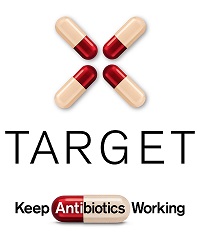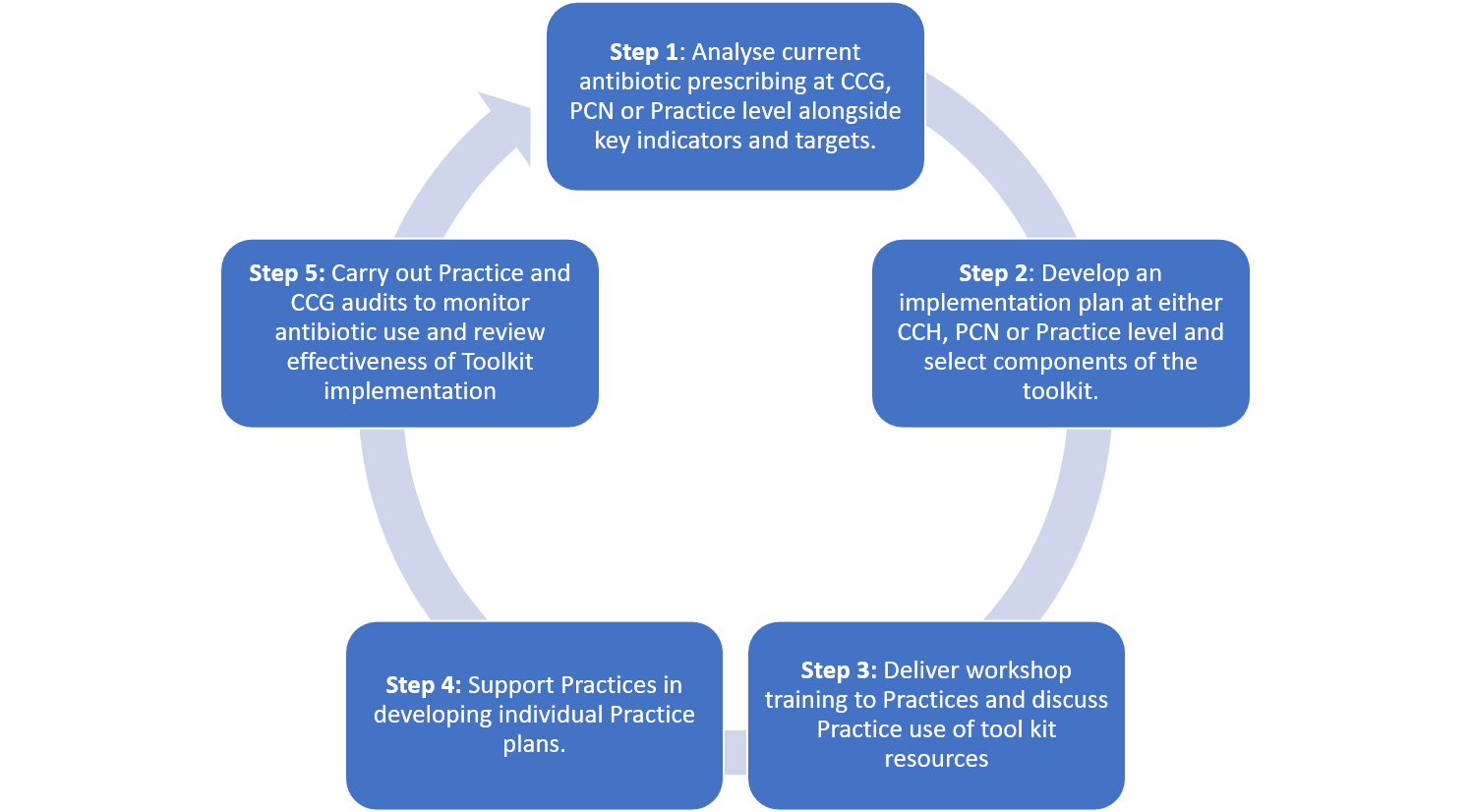Getting the most from the TARGET toolkit
| Site: | Royal College of General Practitioners - Online Learning Environment |
| Course: | TARGET antibiotics toolkit hub |
| Book: | Getting the most from the TARGET toolkit |
| Printed by: | Guest user |
| Date: | Wednesday, 10 December 2025, 8:15 AM |
Description
 TARGET stands for: Treat Antibiotics Responsibly, Guidance, Education, Tools. The Toolkit includes a range of free resources that can each be used to support prescribers’ and patients’ responsible antibiotic use.
TARGET stands for: Treat Antibiotics Responsibly, Guidance, Education, Tools. The Toolkit includes a range of free resources that can each be used to support prescribers’ and patients’ responsible antibiotic use.
Version 1.0, November 2021.
What is TARGET?
Developed by the UK Health Security Agency (UKHSA), the Royal College of General Practitioners (RCGP) and the Antimicrobial Stewardship in Primary Care (ASPIC) Group, TARGET is the central resource to help primary care healthcare professionals and commissioning organisations improve antibiotic prescribing. Using the TARGET Antibiotics Toolkit resources will also enable primary care organisations to demonstrate compliance with the Health and Social Care Act 2008: Code of Practice on the prevention and control of infections and related guidance.
These guides help you navigate the TARGET resources:
Who is the toolkit for and how can it be used?
To get maximum effect regarding antibiotic use, all or as many as possible of the resources should be used with action planning by those involved in antimicrobial stewardship activities such as those from clinical commissioning groups (CCGs) and primary care networks (PCN), prescribers working in primary care, and those involved in training prescribers around infection management. Collectively, the TARGET resources will support practices in planning, implementing and reviewing activity in delivering quality improvement programmes relating to antimicrobial stewardship. A recent rigorous RCT evaluation in routine general practice showed that a one hour TARGET workshop given by local GPs, microbiologists or medicine managers, combined with demonstrating the resources, significantly reduced antibiotic use.
It is essential to plan and monitor implementation of the TARGET Antibiotics Toolkit appropriately and this is best achieved by developing a local antibiotic action plan, either for your CCG or your practice. It is important that this plan is developed using a whole team approach so that everyone who is involved in communication and prescribing around antibiotics has had the opportunity to contribute.
Each CCG, PCN and Practice has different prescribing pressures and priorities. It is therefore also important that prescribers take ownership of the planning process as well as the adaptation and implementation of resources at a local level. Before beginning the planning process we recommend you appoint a local antibiotic champion from within the CCG or the practice. This could be a prescribing lead, GP with a specialist interest in infection management, nurse practitioner, clinical pharmacist, or any other person who can be responsible for antimicrobial stewardship in your practice, your PCN or CCG. This is someone who has responsibility for leading on all issues relating to antibiotics and leads the development and implementation of the antibiotic action plan.
In order to maximise effectiveness of the TARGET resources, users should plan, monitor and review the implementation as part of a cyclical process as follows:
TARGET Toolkit implementation cycle
Abbreviations: CCG = Clinical Commissioning Group; PCN = Primary Care Network

Theoretical background
The TARGET resources are based on several behavioural theories, the Theory of Planned Behaviour, the Behaviour Change Wheel and the Theoretical Domains Framework.
The model proposes that human behaviour is driven by three considerations and these considerations are able to predict whether a person intends to do something. These are:
- Personal Attitude and outcome beliefs: Whether the person is in favour of doing something
- Subjective Norm and normative values: How much the person feels social pressure to do it
- Perceived Behavioural Control and control beliefs: Whether the person feels in control of the action in question
Thus, in order for prescribers (individual and teams), and patients to change their antibiotic use they need to:
- be convinced of the importance of antibiotic resistance and how their responsible antibiotic use can contribute to controlling resistance.
- have the confidence, motivation and tools to use antibiotics responsibly.
The Theory of Planned Behaviour Applied to the TARGET Toolkit
Abbreviations: CCG = Clinical Commissioning Group

In this context, the TARGET Antibiotics Toolkit attempts to:
- influence personal attitudes to antibiotic resistance by emphasising the patient and population benefits of reducing antibiotic use and by showing that appropriate prescribing can make a difference to resistance;
- influence the subjective norms by raising awareness in the practice and nationally of the importance of antibiotic resistance and responsible prescribing, by feeding back practice prescribing rates compared to other practices locally and nationally and by describing the strategies used by peers to reduce antibiotic prescribing;
- influence perceived behavioural controls by increasing confidence of prescribers and patients to use antibiotics responsibly using guidance and leaflets and explaining how barriers to reducing antibiotic prescribing can be overcome.
Using a combination of the different TARGET resources can increase an individual’s intention to “use antibiotics responsibly”. However, other external barriers and patient characteristics may still influence or prevent responsible prescribing.
- Action planning within a practice or out of hours team is essential to move the intentions into actual actions.
- Audits are important to monitor changes in prescribing and highlight the need to discuss other external barriers.
- Incentives or indicators will influence behaviour through changing personal attitudes and subjective norms.
The Behaviour Change Wheel
The Behaviour Change Wheel (BCW) was developed to inform interventions to change behaviour. In the centre of the BCW is a ‘behaviour system,’ which describes essential conditions for a behaviour to occur; capability, opportunity, and motivation (COM) must interact to generate a behaviour.
- Capability - the individual’s psychological (self efficacy) and physical capacity (control, skills) to engage in the activity concerned.
- Motivation - brain processes that energize and direct behaviour, it includes habitual processes, emotional responding (fear, attitudes), as well as analytical decision-making (health motivation).
- Opportunity - factors that lie outside the individual that make the behaviour possible or prompt it. (barriers, cues to action, social norms)
While this is a model of behaviour, it also provides a basis for designing interventions aimed at behaviour change. Interventions and policy changes can be designed to target aspects of the behaviour identified in the COM behaviour system; some interventions may target multiple areas of behaviour.
The Behaviour Change Wheel (adapted from Michie, 2011)
The Theoretical Domains Framework
The Theoretical Domains Framework (TDF) was developed by a collaboration of behavioural scientists and researchers in order to develop a ‘one-size-fits-all’ evidence based, theory-informed framework to identify determinants of behaviour. The TDF includes 14 domains to describe behaviour (see table below), for example, knowledge, skills, beliefs about capabilities.
The TDF can be a theoretical basis for research to identify behaviours which can be targeted with interventions. The TDF can be used hand-in hand with the Behaviour Change Wheel, as the domains of the TDF can fit into the COM Behaviour system.
The TARGET team often use the TDF and BCW in research studies to inform the development of interventions, to evaluate the implementation of interventions.
The Theoretical Domains Framework and COM-B Behaviour system. Adapted from (Atkins, 2017)
References:
- Michie S, van Stralen MM, West R. The behaviour change wheel: a new method for characterising and designing behaviour change interventions. Implement Sci. 2011 Apr 23;6:42. doi: 10.1186/1748-5908-6-42. PMID: 21513547; PMCID: PMC3096582.
- Atkins, L., Francis, J., Islam, R. et al. A guide to using the Theoretical Domains Framework of behaviour change to investigate implementation problems. Implementation Sci 12, 77 (2017). https://doi.org/10.1186/s13012-017-0605-9
- Ajzen I. (1985) From Intentions to Actions: A Theory of Planned Behavior. In: Kuhl J., Beckmann J. (eds) Action Control. SSSP Springer Series in Social Psychology. Springer, Berlin, Heidelberg. https://doi.org/10.1007/978-3-642-69746-3_2
Privacy statement
TARGET Privacy Statement
On 1 October 2021, the UK Health Security Agency (UKHSA) came into being. An executive agency of the Department of Health and Social Care (DHSC), UKHSA combines many of the health protection activities previously undertaken by Public Health England (PHE), together with all of the activities of the NHS Test and Trace Programme and the Joint Biosecurity Centre (JBC). The processing activities previously undertaken by these organisations and their associated data processors have not changed with the establishment of UKHSA. Individual rights are not affected by this change. We are responsible for planning, preventing and responding to external health threats, and providing intellectual, scientific and operational leadership at national and local level, as well as internationally. UKHSA will ensure the nation can respond quickly and at greater scale to deal with pandemics and future threats. We collect and use personal information to fulfil our remit from the government.
UKHSA’s responsibilities include providing the TARGET (Treat Antibiotics Responsibly, Guidance, Education and Tools) toolkit and supporting NHS England to roll out TARGET training.
The purpose of the TARGET toolkit and training is to provide evidence-based guidance, education and tools to primary healthcare provides to prevent and manage common infections and optimise antibiotic use.
This privacy notice explains what personal information we collect, use and may share as part of any activities with the TARGET toolkit, this includes:
- TARGET contact list
- Stakeholder communication and feedback
- TARGET training roll out
It explains what your rights are if we hold your personal information, and how you can find out more or raise a concern.
DHSC is the data controller for the personal information we collect, store and use to fulfil our remit.